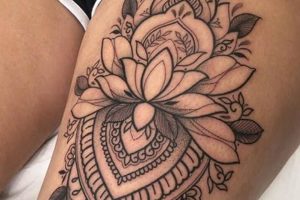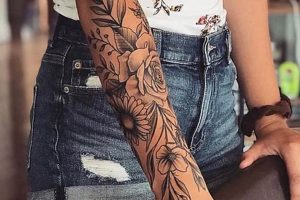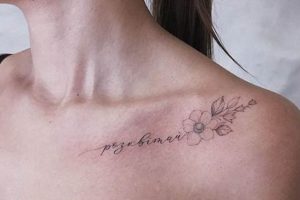Lower back tattoos for women offer a canvas for self-expression through body art. This placement allows for designs ranging from small, delicate pieces to larger, more intricate artwork. Common themes include floral patterns, tribal designs, and symbolic imagery.
The lower back’s location offers a discreet yet alluring placement for a tattoo. It can be easily concealed for professional settings, yet revealed with certain clothing choices. Historically, this area has been associated with femininity and sensuality across various cultures, making it a popular choice for women seeking to express these aspects of themselves. This area also offers a relatively flat and broad surface, which can be advantageous for detailed or expansive designs.
Factors to consider when choosing a lower back tattoo include design aesthetics, pain tolerance, and aftercare requirements. Exploring design styles, consulting with experienced tattoo artists, and understanding the healing process are essential steps in ensuring a successful and satisfying tattoo experience.
Tips for Lower Back Tattoos
Careful consideration is advised when selecting a lower back tattoo due to the area’s visibility and potential impact on clothing choices.
Tip 1: Consider Design Placement and Size: The lower back’s curvature can distort certain designs. Opting for artwork that complements this natural curve is essential for a visually appealing result. Consider the overall size and how it will appear when sitting or bending.
Tip 2: Research Tattoo Artists: Selecting a reputable and experienced tattoo artist specializing in the desired style is crucial. Review portfolios and seek recommendations to ensure quality artistry and hygienic practices.
Tip 3: Reflect on Pain Tolerance: The lower back can be a sensitive area. Discuss pain management options with the chosen artist and prepare mentally for the sensation.
Tip 4: Prioritize Aftercare: Proper aftercare is vital for preventing infections and ensuring optimal healing. Follow the artist’s instructions diligently regarding cleaning, moisturizing, and avoiding sun exposure.
Tip 5: Choose Timeless Designs: Trends change. Opting for a design with personal significance rather than following fleeting fads can prevent future regrets.
Tip 6: Factor in Clothing Choices: Certain clothing styles, such as low-rise jeans or belts, can irritate a newly healed tattoo. Consider wardrobe implications during the healing process.
Tip 7: Consult a Medical Professional: Individuals with certain medical conditions or allergies should consult a physician before getting a tattoo.
Careful planning and informed decision-making contribute significantly to a positive lower back tattoo experience, resulting in a piece of body art that provides lasting satisfaction.
By following these guidelines, individuals can approach the process with confidence and achieve a beautiful, well-executed lower back tattoo.
1. Design Intricacy
Design intricacy plays a significant role in the aesthetic impact of lower back tattoos. The level of detail influences not only the visual appeal but also the time, skill, and cost involved in creating the tattoo. Understanding the nuances of design intricacy allows for informed decisions regarding style, artist selection, and overall satisfaction with the final result.
- Minimalist Designs:
Minimalist tattoos utilize clean lines, simple shapes, and often negative space to create a subtle yet impactful design. Examples include small geometric patterns, single flowers, or delicate script. These designs are generally quicker to execute and heal, making them suitable for individuals with lower pain tolerance or those seeking a less prominent tattoo. In the context of lower back tattoos, minimalist designs can accentuate the natural curves of the body without overwhelming the area.
- Intricate Patterns:
Intricate patterns, such as mandalas, lacework, or detailed floral designs, require a higher level of artistic skill and precision. These designs often involve shading, fine lines, and multiple layers, resulting in a visually captivating piece of art. However, intricate patterns demand more time and multiple sessions, increasing the overall cost and requiring a greater commitment to the healing process. On the lower back, intricate patterns can create a striking statement piece, but careful consideration of placement and size is essential to avoid distortion.
- Realistic Imagery:
Realistic tattoos aim to replicate the appearance of photographs or paintings. This style demands a high level of artistic expertise and can involve portraits, animals, or landscapes. Realistic tattoos require significant time, skill, and often multiple sessions to achieve the desired level of detail. Placement on the lower back can present challenges due to the body’s curvature, requiring careful planning and execution by a skilled artist.
- Tribal Designs:
Tribal tattoos often feature bold lines, geometric shapes, and symbolic imagery inspired by various cultures. The intricacy of tribal designs can range from simple bands to elaborate patterns that cover a larger area. These designs often carry cultural significance and should be researched thoroughly before being permanently inked. On the lower back, tribal designs can create a powerful and visually striking statement, reflecting both personal style and cultural appreciation.
The level of design intricacy chosen for a lower back tattoo significantly impacts the overall aesthetic and should be carefully considered in relation to personal preferences, pain tolerance, budget, and the desired visual impact. By understanding the nuances of each style, individuals can make informed decisions that align with their individual vision and ensure a satisfying result.
2. Size and Placement
Size and placement are critical factors influencing the aesthetic harmony and overall impact of lower back tattoos. The lower back presents a unique canvas with its natural curves and proximity to the spine. Careful consideration of these anatomical features is essential for creating a visually appealing and well-balanced tattoo. A large, elaborate design might appear distorted if not strategically placed to complement the body’s contours. Conversely, a small, delicate tattoo might be lost or appear insignificant if placed incorrectly. For instance, a horizontally oriented design that follows the natural curve of the lower back can accentuate the body’s shape, while a vertically oriented design might appear disjointed or unbalanced.
Placement also affects visibility and discretion. A tattoo positioned directly above the tailbone offers greater visibility, while one placed higher up can be more easily concealed. This consideration is particularly relevant for individuals who require discretion in professional settings. Furthermore, the size of the tattoo should be proportionate to the available space. A large design crammed into a small area can appear cluttered and compromise the clarity of the artwork. Conversely, a small design in a large area might appear isolated and lack impact. A skilled tattoo artist can guide placement decisions, considering the individual’s anatomy and the specific design elements.
Understanding the interplay between size and placement is fundamental to achieving a successful lower back tattoo. Strategic placement can enhance the design’s visual appeal, ensuring it complements the body’s natural contours. Appropriate sizing ensures the design’s clarity and impact while maintaining balance and proportion. These factors, combined with careful design selection and skilled artistry, contribute significantly to a visually satisfying and personally meaningful tattoo.
3. Pain Management
Pain management is a crucial aspect of the lower back tattoo experience. The lower back, while a popular location for tattoos, can be a sensitive area due to the proximity of the spine and the varying thicknesses of skin and muscle tissue. Effective pain management strategies contribute significantly to a more comfortable and positive tattooing process, allowing individuals to better tolerate the procedure and minimizing potential complications. This involves understanding the physiological basis of tattoo pain, exploring available pain relief options, and collaborating with the tattoo artist to implement appropriate strategies.
Tattooing involves repeatedly puncturing the skin with needles to deposit ink into the dermis. This process naturally triggers pain receptors, resulting in discomfort that varies depending on individual pain thresholds, the location being tattooed, and the size and complexity of the design. The lower back, with its network of nerve endings, can be particularly sensitive. Factors such as the proximity to bone, the presence of nerve clusters, and individual variations in skin thickness can all influence the intensity of pain experienced during a lower back tattoo. For example, areas directly over the spine or hip bones tend to be more sensitive than areas with more muscle and fat tissue. Larger, more intricate designs, which require longer sessions and more needle passes, also contribute to increased discomfort. Therefore, anticipating and addressing potential pain is essential for a positive experience. Strategies range from over-the-counter pain relievers to topical anesthetics. Open communication with the tattoo artist about pain tolerance levels allows for personalized strategies, such as breaks during the session or the application of numbing creams. Preemptive measures, such as adequate rest, hydration, and avoiding alcohol or caffeine before the appointment, can also contribute to a smoother experience.
Effective pain management not only enhances comfort during the procedure but also contributes to the overall quality of the tattoo. Excessive pain can cause muscle tension and involuntary movements, potentially affecting the artist’s precision and the final result. Managing discomfort allows individuals to remain relaxed and still, promoting optimal conditions for the artist to work and ensuring the tattoo is applied accurately and evenly. Furthermore, appropriate pain management can minimize anxiety and stress associated with the procedure, contributing to a more positive and memorable experience. Proactive pain management strategies empower individuals to approach their lower back tattoo appointment with confidence and ensure a more comfortable and successful outcome.
4. Artist Selection
Artist selection is paramount when considering a lower back tattoo. This location’s visibility and the potential permanence of the artwork necessitate choosing a skilled professional whose artistic style aligns with the individual’s vision. A thorough selection process ensures the realization of desired aesthetic outcomes and minimizes potential complications.
- Portfolio Review:
A comprehensive portfolio review is essential. Examining an artist’s previous work reveals their technical proficiency, artistic style, and specialization. Focus should be placed on examples of lower back tattoos to assess the artist’s ability to work with the body’s curves and create designs that complement this specific area. Look for consistency in line work, shading, and color saturation, and assess whether the artist’s style aligns with the desired aesthetic.
- Specialization and Experience:
Artists often specialize in particular styles, such as realism, traditional, or watercolor. Selecting an artist specializing in the desired style increases the likelihood of achieving the desired aesthetic outcome. Inquiring about an artist’s experience with lower back tattoos specifically can provide further insight into their expertise and ability to address the unique challenges this location presents.
- Hygiene and Safety Practices:
Maintaining stringent hygiene standards is crucial in tattooing to prevent infections and complications. A reputable artist adheres to strict sterilization protocols, uses single-use needles, and maintains a clean and sanitary workspace. Inquiries about these practices should be made during the consultation process to ensure client safety and well-being. Observing the cleanliness of the studio environment and the artist’s adherence to safety protocols provides further reassurance.
- Consultation and Communication:
Open communication with the artist is vital. A thorough consultation allows individuals to discuss their design ideas, explore potential placement options, and address any concerns. Effective communication ensures that the artist understands the client’s vision and can translate it into a successful tattoo. This collaborative process fosters trust and ensures both parties are on the same page before the tattooing process begins. A willingness to listen, offer suggestions, and address questions demonstrates professionalism and commitment to client satisfaction.
Careful artist selection significantly impacts the outcome of a lower back tattoo. A skilled artist with relevant experience, a commitment to hygiene, and strong communication skills can translate individual vision into a beautiful and well-executed piece of body art that complements the lower back’s unique canvas. Investing time in research and consultation ultimately contributes to a positive and fulfilling tattoo experience.
5. Aftercare Procedures
Aftercare procedures are integral to the success and longevity of lower back tattoos. This area’s unique characteristicsclothing friction, exposure to sweat, and potential pressure during sittingpresent specific aftercare considerations. Neglecting proper aftercare can lead to complications such as infection, ink fading, and scarring, potentially compromising the tattoo’s aesthetic and necessitating costly and time-consuming corrective measures. Conversely, diligent adherence to appropriate aftercare practices promotes optimal healing, preserves color vibrancy, and maintains the integrity of the design.
Immediately following the tattoo application, the artist typically applies a protective bandage. This bandage safeguards the fresh tattoo from bacteria and external irritants. Subsequent aftercare involves gentle cleansing with mild soap and water, avoiding harsh scrubbing or abrasive materials. Application of a thin layer of fragrance-free, hypoallergenic moisturizer keeps the skin hydrated and promotes healing. Protecting the tattoo from excessive sun exposure is crucial, as UV rays can fade ink and irritate the skin. Loose-fitting clothing minimizes friction and allows the tattoo to breathe, promoting faster and more efficient healing. Certain activities, such as swimming or soaking in hot tubs, should be avoided during the initial healing period to prevent infection. For example, tight-fitting jeans or belts rubbing against a healing lower back tattoo can cause irritation, inflammation, and even ink loss. Conversely, wearing loose-fitting clothing and keeping the area clean and moisturized minimizes these risks and facilitates optimal healing.
Appropriate aftercare practices are not merely a post-tattoo consideration; they are an integral part of the entire tattoo process. From the initial consultation to the final healed result, aftercare plays a crucial role in preserving the tattoo’s artistic integrity and promoting long-term satisfaction. Understanding and adhering to these practices demonstrates a commitment to both the aesthetic and the health implications of body art, ensuring a positive and enduring outcome. Neglecting this crucial aspect can undermine the entire process, resulting in complications that compromise the tattoo’s appearance and necessitate further intervention.
6. Cultural Symbolism
Cultural symbolism imbues lower back tattoos with deeper meaning, transforming them from mere aesthetic adornments into powerful expressions of personal identity and cultural heritage. Specific symbols carry diverse meanings across cultures, reflecting historical narratives, spiritual beliefs, and societal values. Understanding this interplay between cultural symbolism and body art allows individuals to select designs that resonate with their personal narratives and express a connection to a particular cultural heritage. For example, in some Polynesian cultures, intricate patterns tattooed on the lower back represent genealogy and social status, while in certain Asian traditions, lotus flowers symbolize purity and enlightenment. Choosing a symbol with cultural significance adds layers of meaning to the tattoo, reflecting not just personal aesthetics but also a connection to a broader cultural narrative.
The placement of the tattoo on the lower back can itself carry cultural significance. In some cultures, this area is associated with femininity, sensuality, and life-giving energy. Choosing to place a culturally symbolic tattoo on the lower back can further amplify its meaning, creating a powerful statement of identity and belonging. However, it’s crucial to research the specific cultural connotations of a chosen symbol before permanently inking it onto the body. Misinterpretations or misappropriations of cultural symbols can be offensive and disrespectful. Consulting with cultural experts or individuals from the relevant cultural background can provide valuable insights and ensure respectful representation. For instance, certain tribal designs carry specific meanings within their respective cultures and should not be used lightly or without understanding their significance. Respectful engagement with cultural symbolism demonstrates an appreciation for the richness and diversity of human expression.
Integrating cultural symbolism into lower back tattoo designs allows individuals to connect with their heritage, express personal values, and create a powerful visual narrative. However, this practice requires careful consideration, research, and respect for the cultures from which these symbols originate. Thoughtful selection and placement of culturally symbolic tattoos transforms body art into a powerful medium for storytelling, self-discovery, and cultural preservation. By understanding and appreciating the symbolic weight of these designs, individuals can create meaningful and enduring works of art that reflect both personal and collective identities.
7. Personal Expression
Lower back tattoos offer a unique canvas for personal expression. The placement, often concealed yet easily revealed, allows individuals to control the visibility of their body art, reflecting a sense of intimacy and personal agency. Design choices further amplify this expressive potential. A woman might choose a floral design to represent growth and femininity, a geometric pattern to symbolize order and balance, or a quote to embody a personal mantra. The lower back, with its sensual connotations and historical associations with femininity, can become a space where deeply personal narratives are inscribed onto the body. For instance, a woman who has overcome a significant challenge might choose a phoenix tattoo on her lower back, symbolizing resilience and rebirth. This personal narrative, etched onto the skin, becomes a source of empowerment and a reminder of personal strength. The discreet nature of the placement adds another layer of meaning, suggesting a private message of resilience known only to the individual and those with whom she chooses to share it.
The process of selecting a lower back tattoo itself becomes an act of self-discovery. Researching different design styles, exploring symbolic meanings, and collaborating with a tattoo artist involves introspection and careful consideration of one’s values, beliefs, and aesthetic preferences. This process allows individuals to connect with their inner selves and translate their personal narratives into a visual representation. The permanent nature of the tattoo underscores the commitment to this self-expression, marking a significant moment or period in one’s life. For example, a woman might choose a tattoo to commemorate a loved one, mark a milestone achievement, or celebrate a personal transformation. This permanent inscription becomes a tangible reminder of personal growth and a symbol of self-acceptance.
Ultimately, lower back tattoos function as a powerful medium for personal expression. They allow individuals to communicate their identities, values, and experiences through a visual language inscribed onto their bodies. This form of self-expression empowers individuals to reclaim their bodies, celebrate their individuality, and share their stories with the world, whether openly or discreetly. The lower back, as a canvas, offers a unique space where personal narratives intersect with cultural symbolism and aesthetic preferences, resulting in a powerful and enduring form of self-expression.
Frequently Asked Questions
Addressing common inquiries regarding lower back tattoos provides clarity and facilitates informed decision-making. The following questions and answers offer valuable insights for individuals considering this form of body art.
Question 1: How much do lower back tattoos typically cost?
Pricing varies based on design complexity, size, artist experience, and studio location. Obtaining quotes from multiple reputable artists is recommended.
Question 2: Is the lower back a painful location for a tattoo?
Pain tolerance is subjective. The lower back can be more sensitive than other areas due to its proximity to the spine and bone. Discussing pain management options with the chosen artist is advisable.
Question 3: How long does a lower back tattoo take to heal?
Healing typically takes several weeks, depending on individual factors and adherence to aftercare instructions. Complete healing can take up to several months.
Question 4: Can lower back tattoos be covered up easily?
Lower back tattoos are easily concealed with clothing. This placement offers discretion in professional or formal settings.
Question 5: Will a lower back tattoo stretch or distort during pregnancy?
Pregnancy can affect skin elasticity. While some stretching or distortion is possible, maintaining a healthy weight and following proper skincare can minimize these effects.
Question 6: Are there any specific design considerations for lower back tattoos?
Designs that complement the lower back’s natural curve are generally recommended. Consulting with an experienced artist to discuss design placement and size optimization is essential.
Thorough research and consultation with experienced professionals are crucial for ensuring a positive and satisfying lower back tattoo experience. Addressing these common concerns empowers individuals to make informed choices and achieve desired aesthetic outcomes.
Further exploration of specific design styles and cultural symbolism provides additional guidance in selecting a meaningful and visually appealing lower back tattoo.
Conclusion
Careful consideration of placement, design intricacy, artist selection, pain management, and aftercare practices are crucial for successful lower back tattoos. This body art form offers significant potential for personal expression, allowing individuals to communicate narratives through carefully chosen designs and culturally symbolic imagery. The lower back’s unique characteristics present both opportunities and challenges, requiring informed decision-making at each stage of the process, from initial concept to long-term care. Addressing these elements thoroughly empowers individuals to achieve aesthetically pleasing and personally meaningful results.
Ultimately, a well-executed lower back tattoo becomes an enduring piece of personal art, reflecting individual style, cultural heritage, and personal narratives. The fusion of artistic skill, informed choices, and diligent care ensures a lasting and positive representation of self-expression.







